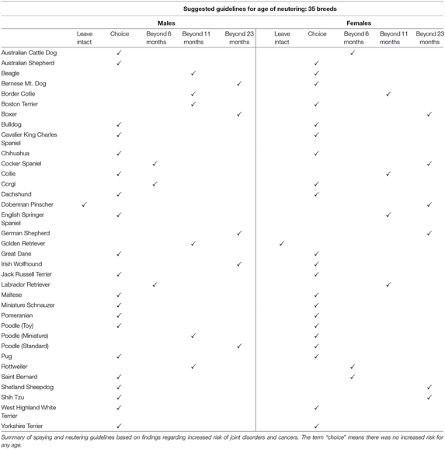| print
link to this post | email a friend When to Spay & Neuter - Based on Research!26 Mar 2022 Review compiled by Laurie Edge-Hughes, BScPT, MAnimSt (Animal Physio.), CAFCI, CCRT
I have posted this article elsewhere on Facebook, but wanted to dive into this paper here as well. Here goes! https://doi.org/10.3389/fvets.2020.00388
Hart BL, Hart LA, Thigpen AP, Willits NH. Assisting decision-making on age of neutering for 35 breeds of dogs: Associated joint disorders, cancers, and urinary incontinence. Front. Vet. Sci., 07 July 2020.
The introduction discusses what is currently in the literature.
What was done in this study? In an attempt to address the absence of breed-specific information on joint disorders and cancers associated with neutering, the authors undertook a project focusing on various specific breeds using data collection and analyses with their extensive veterinary hospital database where the same diagnostic criteria could be applied to all breeds.
The joint disorders examined included cranial cruciate ligament tears or rupture (CCL), hip dysplasia (HD) and elbow dysplasia (ED). The cancers examined, which previous studies found could be affected by neutering, were lymphoma/lymphosarcoma (LSA), hemangiosarcoma (HSA), mast cell tumors (MCT), and osteosarcoma (OSA).
The final list of 35 (including three varieties of Poodle) represented in the present study are, alphabetically, the: Australian Cattle Dog, Australian Shepherd, Beagle, Bernese Mountain Dog, Border Collie, Boston Terrier, Boxer, Bulldog, Cavalier King Charles Spaniel, Chihuahua, Cocker Spaniel, Collie, Corgi (Pembroke and Cardigan combined), Dachshund, Doberman Pinscher, English Springer Spaniel, German Shepherd Dog, Golden Retriever, Great Dane, Irish Wolfhound, Jack Russell Terrier, Labrador Retriever, Maltese, Miniature Schnauzer, Pomeranian, Poodle-Miniature, Poodle-Standard, Poodle-Toy, Pug, Rottweiler, Saint Bernard, Shetland Sheepdog, Shih Tzu, West Highland White Terrier, and Yorkshire Terrier.
The original paper (click on the link, it’s free access) lists everything found for each breed. Here’s a sample.
Shetland Sheepdog “The study population was 31 intact males, 30 neutered males, 20 intact females, and 52 spayed females for a total sample of 133 cases. There were no joint disorders in intact males and just one in the intact females. In neutered males, the only joint disorder was in one of the males neutered at <6 mo. and in females there was no joint disorder associated with spaying. The occurrence of cancers in intact males was 6 percent and in intact females, zero. There were no evident increases in cancers in neutered males or females. There was no occurrence of MC (mammary cancer) in intact or spayed females and a 14 percent occurrence of PYO (pyometra) in intact females. Spaying at 6-11 mo. resulted in a 6 percent occurrence of UI (urinary incontinence), but at 1 year a 33 percent occurrence. Lacking a noticeable occurrence of increased joint disorders or cancers in neutered males, those wishing to neuter should decide on the appropriate age. However, to avoid the high level of UI occurrence in females, one could consider spaying females at, or beyond, 2 years.”
This table is a summary of recommendations for each breed in regards to spay / neuter. As a conclusion, the author stated the following, “In conclusion, the data presented should provide to veterinarians and interested puppy caregivers data-based information for the best age for neutering to avoid increasing the risk of joint disorders and some cancers beyond that of leaving the dog intact. Readers can note that an elevated risk for a joint disorder or cancer occurs in relatively few of these breeds. In other words, with most breeds or sexes, neutering can apparently be done without referral to a particular age, at least with regard to the joint disorders or cancers covered in this study.”
Further research / data compilation is being conducted by the same researchers to look at mixed breed dogs as well.
So, there you go! Some great guidelines in regards to advising or discussing spay and neutering with your puppy owners! Food for thought!
|

|


